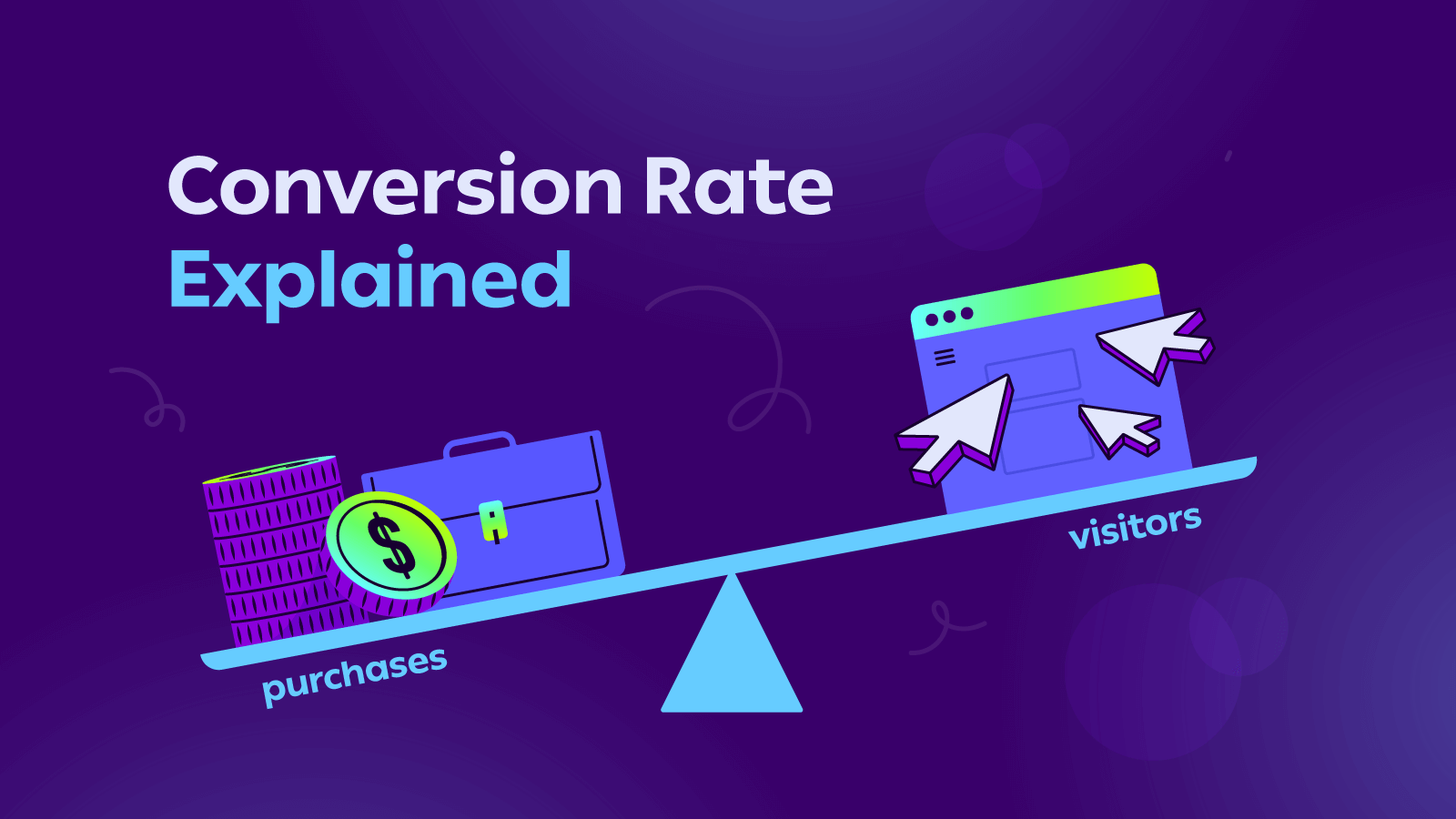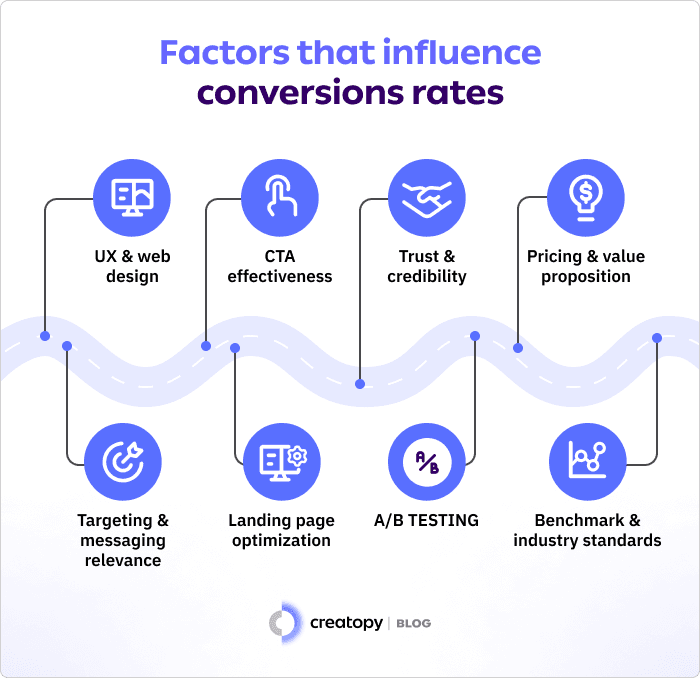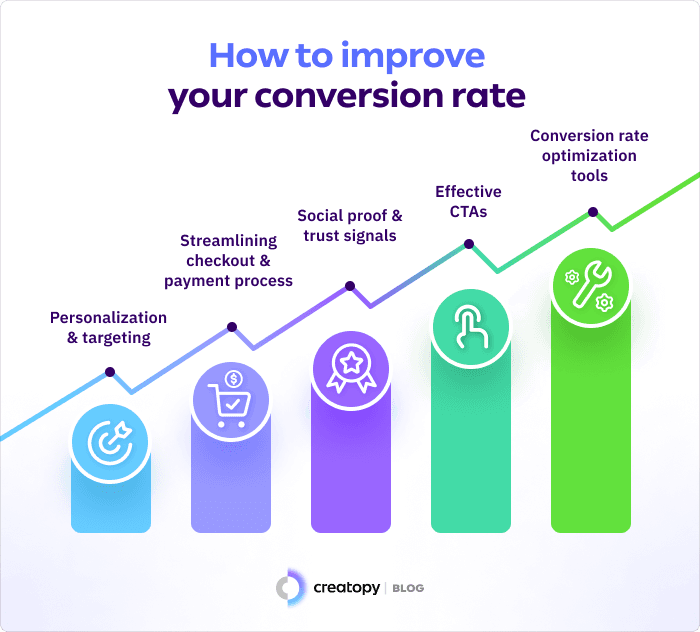The Ultimate Guide to Facebook Event Photo Sizes (2025 Update)
Diana Teslaru
Apr 15, 2025 - 9 min read
Are you an agency? Scale your team's work and impact with The Agency Package.

Measuring the performance of all your marketing efforts is crucial – but no other metric is as quintessential as your conversion rate. This is it – this is where it all comes down to in the end: bringing your target audience to take action, buy something from you, or become part of your community.
In this article, we take a closer look at conversion rate from multiple perspectives: what it actually is, why you should really care about it, and how to work with it to achieve your business goals.
Read on to find out how to boost conversions in 2023.
The conversion rate is a metric that measures the number of visitors to a website or webpage who take a desired action, such as completing a purchase or signing up for a newsletter.
It is worth noting that most people will refer to "conversion rates" when there's a financial transaction involved (i.e., buying something), but this is not necessarily the only dimension of a conversion rate. Conversion rates can measure any desired action, including signing up for a newsletter, downloading an ebook, or clicking a link.
The conversion rate formula is established according to the specific medium in which conversions are taking place, as well as your specific goals. For instance, if you want to measure conversion rates on a web page, you will divide the total number of conversions on page by the number of unique visits the page has recorded.
Regardless of how you look at it, improving conversion rates is an effort that will be more than worth it – not only will it drive more revenue, but it will also create a better user experience (which will increase loyalty and advocacy too, in the end).
Your conversion rate is one of the single most important metrics to measure, as it will indicate the effectiveness of your design, messaging, and offer. A high conversion rate can mean the difference between a successful and unsuccessful website, as it is a key indicator of how well your web pages perform.
To calculate your website’s conversion rate, simply divide the number of conversions (e.g., purchases) by the total number of visitors to the page. For example, if you have 100 visitors and ten purchases, then your conversion rate would be 10%.

Generally, a good website conversion rate is considered to range between 2% and 5%. In an analysis run by Wordstream, they uncovered that the median conversion rate across a range of accounts was 2.35%. However, the top 25% of best-performing accounts had a conversion rate of 5% or higher, indicating that if you want to be among the best, you should strive for a conversion rate higher than the median.
These are general numbers, though. A "good" conversion rate may depend on a variety of factors, such as your industry or the actual channel you're measuring. For instance, in eCommerce, a good conversion rate could be:
Across different industries, average conversion rates can be even more diverse:

And if we look at different channels across multiple industries, a "good" conversion rate may look like this:

In other words, determining a universally good conversion rate is nearly impossible. So, if you want to assess the performance of your ads and compare them with benchmarks (which you should), make sure you look at statistics for your industry and for the specific channel you're engaging with.
Furthermore, make sure you apply channel-specific metrics and conversion optimization tactics. For instance, lowering search advertising costs is not necessarily the same as increasing conversion rates for display ads, as there are specific strategies, techniques, and best practices to test and apply.
To assess your conversion rate, you must also be aware of the two main types of conversion:
Macro conversions are the primary business objectives a website should strive for. This type of conversions directly drives revenue. For instance, macro conversions usually refer to purchases and financial transactions in an eCommerce store. In a SaaS business, macro conversions may refer to signing up for a trial or plan.
Micro conversions are smaller goal actions a website should optimize for. They don't necessarily lead to a purchase or financial transaction, but they are still essential for improving the user experience, providing valuable data, and finding more qualified leads. Examples of micro conversions include signing up for a newsletter or webinar, downloading an ebook, clicking on a link, responding to an ad, joining a forum or group, and filling out an online form.

Nailing good conversion rates isn't a set recipe. But once you know the main ingredients of what makes good conversion rates, you can plan, design, and optimize your website more effectively.
Here are some of the main factors that influence conversion rate:
A good user experience and website design are essential for driving conversions. You need to make sure your users easily understand the information they're presented with and that the entire web design aims to convert visitors into customers. The website design should build trust and credibility, be visually pleasing, use effective copywriting, and load quickly. Some of the most important user experience (UX) and web design tips to keep in mind include:
Your pages need a call-to-action (or more) to encourage people to do something, whether that's a sign up, a purchase, or a download. To make sure your CTAs are effective, keep the following tips in mind:
Trust and credibility are essential factors when it comes to conversion rates. After all, the more people trust your website, the more likely they will make a purchase. Here are some tips for building trust and credibility:
Pricing is also an important factor when it comes to driving conversions. Pricing can make or break a sale. When setting up your pricing, consider the value you’re offering and ensure it reflects that. If you’re offering something worthwhile, visitors will be more likely to take action.
You can also use different pricing strategies to drive conversions, such as offering discounts, packages, free trials, demos, or free versions of your products.
Your ads, landing pages, emails, and other content should be relevant to your target audience. Make sure you use the right messaging and focus on the right channels to reach your target audience.
It’s also important to personalize your messaging as much as possible so it resonates with each user. Every segment of your target audience will likely react to something different, so adjust your messaging to each group for the best results.
Your landing page needs to be optimized to drive conversions. And for that to happen, both your design and your copy need to be on point. Some of the essential tips to keep in mind include:
You can't really know how your website is performing unless you measure it. This means you should measure:
Once you have the data, you can use A/B testing to find out which version of a page performs better. However, when running A/B tests, make sure only to test one element at a time, so the data you are collecting is accurate, relevant, and actionable.
While not infallible, benchmarks and industry standards can offer you a relatively good idea of what's normal in your industry. This data can be used to measure and compare your current performance against the rest of the market.

Just because your conversion rate isn't great, it doesn't mean you can't change that. Here are some tips to keep in mind:
Offering personalized experiences to each customer segment can help you stand out. When you target each segment with relevant messaging that resonates, you can increase your conversion rate. Some personalization and targeting methods include:
Your entire website experience should feel like a stroll in the park—not an endless maze. Ensuring your navigation and user flow is optimized can help to drive conversions. Make sure each step is easy to understand and that it clearly shows users what the next step should be.
Your checkout process should be as simple and straightforward as possible. The average checkout abandonment cart across different industries is just a bit under 70% and some of the most common reasons behind this include:
Removing these potential obstacles can lower your checkout abandonment rate and increase conversions.
Social proof and trust signals are essential for driving conversions. These can include customer reviews, success stories, certifications, logos of companies you have worked with, etc. Make sure these signals and the social proof are visible and well-highlighted, so website visitors can actually see them.
CTA plays an important role in driving conversions. They're literally your gate to customers taking action. Your CTA should be enticing, visible, and should stand out. Ensure it's relevant to your offer and resonates with the target audience.
Conversion Rate Optimization (CRO) tools help you go beyond knowing what is your conversion rate: they measure, analyze, A/B test, and optimize your website for better conversions. Some of the most popular software options in this category include Optimizely, VWO, and Google Optimize.
Heatmapping tools measure user engagement and behavior on your website and display it with a visual representation. This helps identify areas where users struggle or succeed, so you can make better decisions. Hotjar and Crazy Egg are some of the most popular tools in this group.
Analytics tools help you understand the performance of your website and track key metrics. Google Analytics, Mixpanel, and KISSmetrics are very popular with marketers for their abundance of data.
Automation software is crucial when you want to ensure you deliver the right message to the right people on auto-pilot. Some of the leading software companies in this field include Marketo, Hubspot, and ActiveCampaign.
If you want to optimize your web pages for SEO (and you do!), some of the most popular tools in this field include SEMrush, Ahrefs, and Moz.
Likes, traffic, impressions—they're all nice metrics to follow when you want to track your customers' journey (and nudge them to the final stage). But conversions are the real score that matters when it comes to your bottom line.
Keep in mind, though: knowing what your conversion rate is and recording numbers in a spreadsheet is never enough. You have to make adjustments, test what works best, iterate, and scale. And all that takes hard work, good analytical skills, and patience.
By implementing effective conversion rate optimization techniques, you can bring more revenue into your business, and keep your customers happy. It may not be the easiest or most straightforward thing to do, but it will be more than worth it.
7 days free on us
Let's put these insights into action. Build, scale, and automate campaigns with AI-powered workflows.
Diana Teslaru
Apr 15, 2025 - 9 min read
Claudia
Mar 27, 2025 - 22 min read
Diana Teslaru
Jan 5, 2025 - 7 min read
Loredana Harsana
Dec 19, 2024 - 8 min read